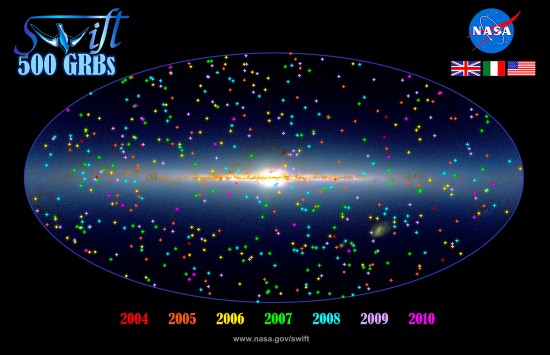Jun 22, 2015
Gamma ray bursts might not be so far away.
Astrophysicists describe gamma-ray bursts (GRB) as due to the “merging of neutron stars” or gamma-ray light radiating from supernova explosions. Recently, the SWIFT satellite’s Burst Alert Telescope detected a beam of gamma radiation so intense that it could have been seen by anyone looking up at that exact point in the sky, even without a telescope, despite calculations that indicate it was over 7 billion light-years away.
Extreme forms of supernovae are said to emit gamma-ray bursts. As astrophysicists speculate, those same supernovae often occur in stars containing many times the mass of the Sun and can not stop their collapse once their fusion cores implode. Such an intense gravitational field causes supernovae remnants to form black holes. Irrespective of the process, it is not known how a supernova explosion and the subsequent collapse into a black hole generates a GRB.
The estimated size of a gamma-ray burst depends on its distance, so what does that mean for GRB measurements? The first few GRBs were found in galaxies with high redshift – some seeming to emanate from as far away as 12 billion light years. If those galaxies actually were that far away, the energies observed in such gamma-ray flashes would be beyond any supernova. Therefore, a hypothetical cosmic entity known as a hypernova was created, salvaging the redshift-indicates-distance theory.
In an Electric Universe, cosmic rays are accelerated by another method: double layers. Double layers were described in 1929 by plasma pioneer and Nobel laureate Irving Langmuir. They form when electric charge flows through plasma. Another Nobel laureate, Hannes Alfvén, described a double layer as, “… a plasma formation by which a plasma—in the physical meaning of this word—protects itself from the environment. It is analogous to a cell wall by which a plasma—in the biological meaning of this word—protects itself from the environment.”
Plasma physicist Alex Dessler wrote: “When I entered the field of space physics in 1956, I recall that I fell in with the crowd believing, for example, that electric fields could not exist in the highly conducting plasma of space. It was three years later that I was shamed by S. Chandrasekhar into investigating Alfvén’s work objectively. My degree of shock and surprise in finding Alfvén right and his critics wrong can hardly be described. I learned that a cosmic ray acceleration mechanism basically identical to the famous mechanism suggested by Fermi in 1949 had [previously] been put forth by Alfvén.” — Quoted in Anthony L. Peratt, “Dean of the Plasma Dissidents“, Washington Times, supplement: The World and I (May 1988).
Another explanation for GRB intensity is that redshift is not actually an indicator of distance and GRBs are occurring in nearby galactic neighborhoods. It is likely that some galaxy clusters are not so far away and are not so large. In that same way, GRBs are not unimaginably powerful, not coming from the edge of a speculative expanding space/time continuum, and are not the birth pangs of a black hole.
If GRBs are located nearby they are less energetic and plasma discharges in the form of exploding double layers could impel the gamma-ray bursts in ways that can be explored though laboratory experiments. Rather than relying on mathematical phantoms like black holes, neutron stars and hypernovae, why not create real, testable hypotheses and work them up with real, physical models?
Standard cosmological theories are hard-pressed to match models with observations. X-rays from ion excitation, a range of energy curves, and (sometimes) gamma-rays are properties of lightning bolts. Computer simulations demonstrate that plasma phenomena are scalable over several orders of magnitude – they behave in the same way and illustrate basic premises whether in atoms or galaxies. Perhaps GRBs are really flashes of cosmic lightning erupting from immense, electrified clouds of plasma.
Stephen Smith













